The ostrich is one of the strangest animals alive today. It has fairly ancient origins, as it’s one of the few remaining flightless birds, and sometimes behaves in a way that seems out of place based on the evolution of creatures around it. However, despite the world changing around it, the ostrich mostly just continues to do its own unique thing. While many people think of ostriches as cowardly or stupid creatures, they are actually quite ferocious fighters when necessary, and have a cunning intelligence that has managed to allow them to survive and even thrive for ages against some of the deadliest predators on the planet. The ostrich is far more than it appears, and is useful for much more than most people know.
10. Ostriches Do Not Actually Bury Their Heads In Sand

One of the most enduring myths about the ostrich, and the thing people know best about them, is that they bury their heads in the sand when they are threatened or sense danger. They simply refuse to deal with the situation in front of them, no matter how obvious and horrible it is. They take on the strategy that “If I can’t see them, they can’t see me”, making them one of the stupidest animals ever. However, as you might imagine because we said it was a myth, none of the above is actaully true.
The ostrich does not bury its head in the sand to hide from danger. The myth stems from the fact that the ostriches are often bending their heads down to peck at food on the ground, or to regularly turn their eggs which are partly buried in the dirt, so it looks like they are regularly hiding their heads in sand. According to behaviorial experts on ostriches, they actually have a different way of reacting when threatened. If they think they cannot run away in time and are trying to hide from predators, they will flop to the ground on their sides and try to look like another bush. If they feel they are going to be attacked anyway, or their eggs are threatened, they will fight with their powerful legs.
9. Ostriches Have The Largest Egg Laid By A Bird In Existence
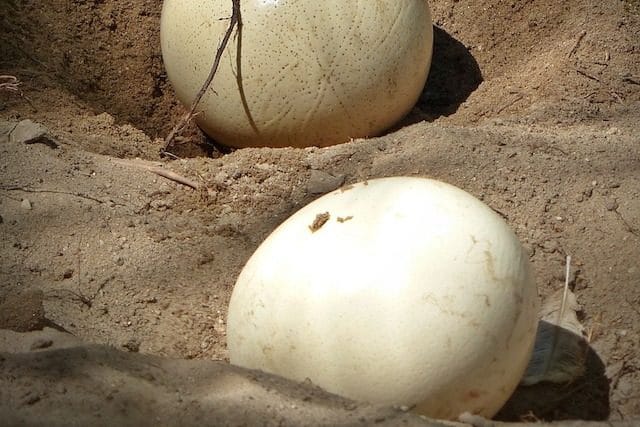
Ostriches are the largest flightless bird living today, and also happen to lay the largest eggs of any living bird in existence today. In fact, the Guiness World Record for the largest egg laid by a bird was achieved back in 2008 in a farm in Sweden – the egg weighed a whopping 5 pounds and 11.36 ounces, which is absolutely massive compared to the eggs we usually eat for breakfast. A typical ostrich egg that does not even reach record breaking standards is equivalent to about two dozen chicken eggs.
While it may sound like a crazy luxury, ostrich eggs are starting to pop up around some speciality markets in the United States, although they are fairly expensive considering the size and how many people they can feed in one go – not to mention the relative rarity of ostrich farms. They are also quite difficult to cook and require not only a lot of prep time and cooking time, but specialized equipment. The shells of ostrich eggs are so thick that most people recommend getting into them by boring into it with an electric drill. They usually take about two hours to cook, and due to the thickness of the shell, you have to take care not to overcook it.
8. Ostriches Sleep In A Way Similar To That Of The Platypus

The ostrich is one of the animals on earth that has survived in a similar state for a lot longer than many, and for this reason, it actually has some very odd features regarding its sleep cycle. Scientists observed ostriches standing upright, with their necks relaxing a bit, and ocassionally jerking upright, as well as their eyes seeming to close more often. They at first interpreted this as a sign that the ostrich was getting sleepy, but it turns out that at this stage, the ostrich was already asleep. The ostrich sleeps standing up, and for part of its sleep cycle, its eyes can be open and it can even look entirely alert.
Ostriches also have the interesting feature that they tend to very quickly shift between Slow Wave Sleep and Rapid Eye Movement cycles, much faster than most animals today, and even merge some features from both. The other animals they share this with – the echidna and the platypus – don’t share much of any features with the ostrich beyond this, which has led scientists to speculate that the connection has to do with all the animals being some of the oldest to remain mostly unchanged. They believe that this was a earlier evolution of sleep, and that these particular animals have not yet found the need to adapt their sleep to a pattern more commonly found in modern animals.
7. Ostrich Racing Is A Popular Sport In Certain Parts Of Africa And Even The USA
https://www.youtube.com/watch?v=plk35VYDKZE
Most people have heard of horse racing, or even dog racing, but they may be surprised to learn that ostrich racing is also a thing. And while some may assume it is only a sport limited to regions like Africa, where ostriches are found naturally, you can actually find ostrich racing right here in the United States of America. The Chandler Ostrich Festival is held every year in Arizona and recently attracted 100,000 visitors, and ostrich racing was one of the main attractions.
Ostrich racing has a long history in Africa, and has only started to reach popularity in other parts of the world more recently. It can be a fairly dangerous sport as it is easier to fall off an ostrich than it is to fall off a horse, and ostriches are actually extremely fast animals, reaching speeds up to about 43 mile per hour. Tourists who wish to ride ostriches can find places in Africa willing to help you try out the experience and guide you without a lot of the risk. You can also likely get some fun ostrich interaction at the yearly festival in Arizona, if you are interested in experiencing what it is like to ride a two-legged animal.
6. Ostriches Eat Pebbles In Order To Help Them Digest Their Food
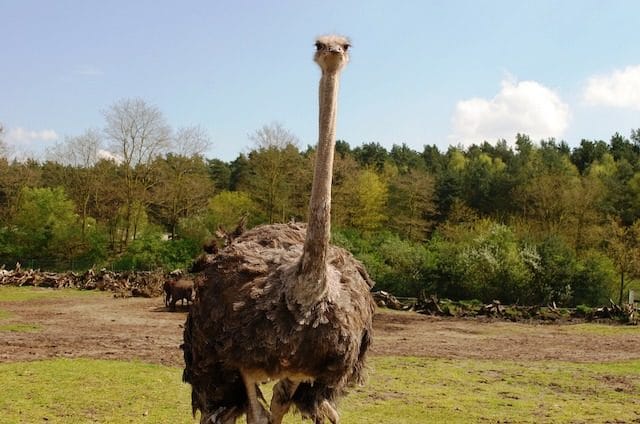
If you ever own an ostrich for any reason and see it eating glass or pieces of gravel or other things, you may be alarmed, but you should not be. If you do not allow your ostrich to eat sharp objects, it will actually die. Ostriches are an animal that eats food that requires a fair amount of processing, but their stomach cannot do the work alone, and they do not have teeth. They have a different take on an idea used by another ancient animal, the playtpus. The playtpus gets gravel in its mouth and uses it to grind up food before swallowing.
On the other hand the ostrich swallows gravel and other sharp objects and then uses them as a grinder in its stomach to help break down and digest food that it swallows. These sharp objects in the ostriches stomach, known as gizzard stones, slowly break down over time from use, which means the ostrich needs to regularly eat more gravel, glass and other sharp bits to keep its stomach functioning properly. At any given time, the mass in the ostriches stomach made up of gizzard stones is usually roughly 1.5 kilograms – this may sound like a lot of weight to be carrying around in your stomach, but it is necessary for their survival.
5. The Evolutionary Origin Of Ostriches And Similar Flightless Birds Is Different From Once Thought
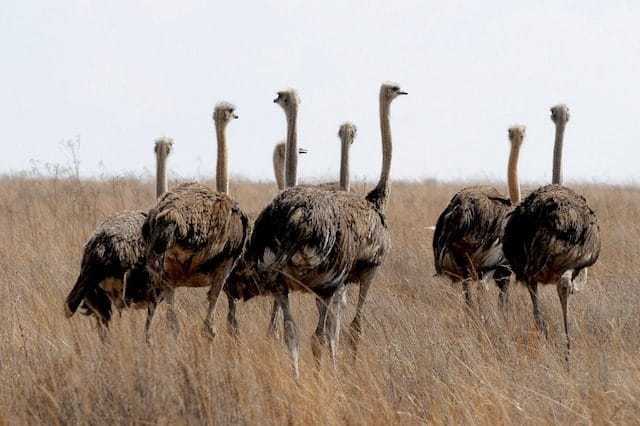
Ostriches are one of the few remaining species of flightless birds called ratites, which also includes birds like the Emu. Long ago, back when megafauna were more common, there were much larger species of these birds living in places like New Zealand, such as the now extinct Moa. Moas were much larger than an ostrich and could reach staggering heights of 12 feet tall. There is good reason to believe that human hunting alone brought the moa to extinction, although if food were not as common, eating Moas as meat may have been more necessary. Mass extinction of humans or animals often happens when there is not enough for all to eat.
Regardless, scientists long believed that when the supercontinent of Gondwana broke up, there was already a large group of similar flightless birds that were separated and evolved small differences over time. However, more recent research shows that it was probably quite the opposite. The supercontinent was separated, and many species of birds actually flew to new homes before evolving to be flightless on their own over time. Some of these birds still, of course, have common ancestors, but it totally changes how many scientists think about the origins of ratites and how they evolved to what they are today.
4. The Ostrich Farming Fad In The USA Failed Years Ago, But It May Be Making A Comeback
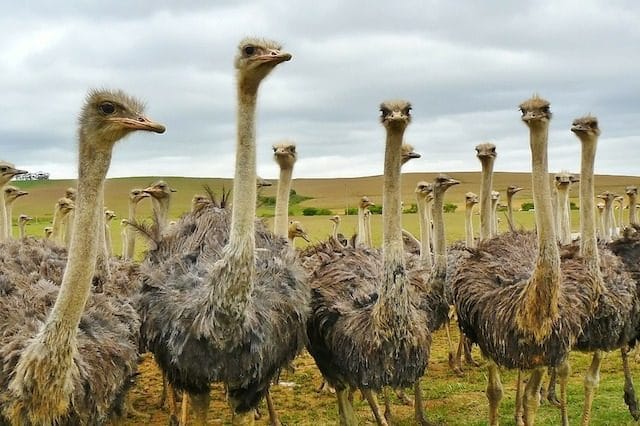
Ostrich farming was a fairly big fad for a while, but it really started to fall apart in the ’90s, and those who relied on ostrich farming to make their money have been struggling ever since. People were trying to make it the latest healthy eating fad, and they may have actually been on to something. Despite being red meat, it is actually fairly safe to eat for those whose hearts are not in great shape, and once you get used to it the taste and texture are perfectly acceptable. Overall, it makes a very healthy substitute for the traditional meat you would use for a hamburger – beef.
However, people were simply not used to ostrich or really expecting it, and the idea of a bird that most people would expect to have meat more like a chicken, producing red meat, as well as eggs, has understandably confused some people. This does not mean you can count out the ostrich farmer yet though – there are still hundreds of ostrich farmers in the USA, and the demand is once again growing. People are looking for healthy, locally grown foods, and ostrich meat provides a great source of nutrition. The eggs are also excellent, as we mentioned earlier – just one egg can produce the nutrional value and rough mass of two dozen regular chicken eggs.
The only caveat here is that ostrich farmers have to be careful not to make the same mistake as last time, where they tried to scale up too quickly, and produced more supply than there was demand, lowering their profits and bursting their own bubble.
3. Male Ostriches Perform A Complicated And Very Bizarre Looking Dance When Trying To Attract Mates
https://www.youtube.com/watch?v=hd-ueLAgIQU
Ostriches may not have fancy feathers like the peacocks in order to strut about and put on a colorful display, but they manage to attract much more attention in their own way. Watch the video above, because this has to be seen to be believed. On more than one occasion, people have witnessed the male ostrich doing its mating dance to attract a female, and it is one of the most bizarre things you will ever see.
It will first sort of drop down to its knees, which are reverse articulated, and then spread its feathers and waggle its whole body back and forth while swaying its wings up and down, left and right, and gyrating its entire body. After this display it will get up and strut about, flapping its wings and moving them in gryations again, in order to put on a showy and powerful display to the nearby female it is courting. Depending on how the female reacts, it may or may not continue the display longer or repeat certain parts, until the female is willing to mate. Sometimes a male will attract multiple females at a time with this dance, and will be seen with several following him around out of interest while he puts on his display. Similar to what happens when TopTenz.net writers hit the club and get loose on the dance floor.
2. The Common Ostrich Is the Fastest Two-Legged Animal
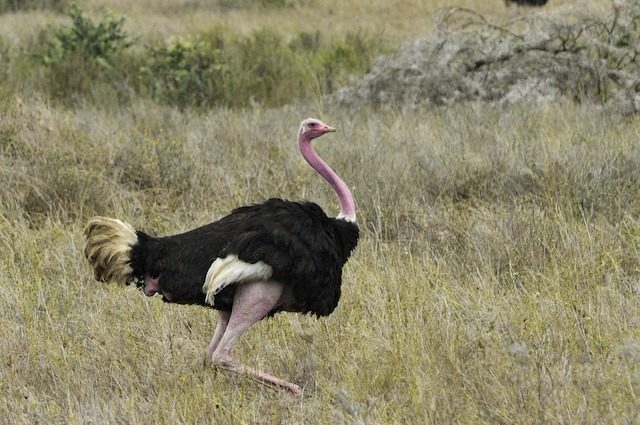
Ostriches are easily the fastest two-legged creature in the world, and this is part of the reason they are prized for racing. An ostrich when pushed or in danger can achieve speeds of up to 43 miles per hour, and can steadily keep up a pace of about 30 miles per hour for 10 miles at a time without needing to slow down or rest. The ostrich needs this ability as its native Africa is very dangerous and there are many predators that are quite speedy that want to make a meal of these flightless birds. The ostrich, with enough advanced warning, can outrun just about anything except for a cheetah, making it the ostrich’s most feared predator.
The reason the ostrich is able to run so fast lies in the fact that it has extremely long legs, with very flexible, almost springy joints that are built for endurance and support. The long legs allow them to take much longer steps than most two-legged animals, and their reverse jointed legs give them better balance. Their legs also have high elasticity, which likely helps them avoid the knee joint damage so common in humans, and helps propel them across the grounds at very high speeds while remaining stable. Scientists who have studied how ostriches walk and run believe that the secrets of ostrich movement could help with the creation of robots, artificial limbs, and help our understanding and treatment of human knee problems.
1. The Ostrich’s Powerful Kick Can Kill Humans (And Even Lions)

As we mentioned earlier, ostriches do not bury their heads in sand when threatened. We also explained that much of the time, the ostrich actually lies on the ground and tries to camouflage itself. However, there are situations where the ostrich knows its predators are going to attack anyway, and it really has no choice except to fight for its life and the lives and future of its eggs or young offspring. In those cases, an ostrich is certainly not at all helpless. Those super long legs they use for running have very powerful claws, and the ostriches will kick out with their legs and do serious damage to anyone trying to make a meal of them, or in general make them feel threatened.
While an ostrich is not always going to win a fight against a dangerous predator, in the past ostriches have been known to kill attacking creatures as large as lions with powerful kicks from their sharply clawed feet. They have also been known on a handful of occasions to kill a human when threatened. They will take their clawed feet and go right for the neck, hoping for a quick kill at their predator’s most vulnerable point. Unfortunately, this is an extremely vulnerable point for most humans, so it is suggested that if you are not an expert, you take great care even around the tamest of ostriches. Just like a horse, they can react suddenly and violently if they feel unexpectedly threatened.